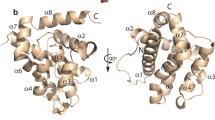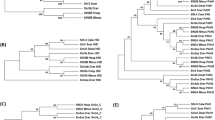Abstract
Programmed cell death (apoptosis) is an evolutionarily conserved process used by multicellular organisms to eliminate cells that are not needed or are potentially detrimental to the organism1,2. Members of the Bcl-2 family of mammalian proteins are intimately involved in the regulation of apoptosis, but, their precise mechanism of action remains unresolved3–5. In Caenorhabditis elegans, the Bcl-2 homologue CED-9 prevents cell death by antagonizing the death-promoting activities of CED-3, a member of the Caspase family of death proteases, and of CED-4, a protein with no known mammalian homologue6–9. Here we show that CED-9 interacts physically with CED-4. Mutations that reduce or eliminate CED-9 activity also disrupt its ability to bind CED-4, suggesting that this interaction is important for CED-9 function. Thus, CED-9 might control C. elegans cell death by binding to and regulating CED-4 activity. We propose that mammalian Bcl-2 family members might control apoptosis in a similar way through interaction and regulation of CED-4 homologues or analogues.
This is a preview of subscription content, access via your institution
Access options
Subscribe to this journal
Receive 51 print issues and online access
$199.00 per year
only $3.90 per issue
Buy this article
- Purchase on Springer Link
- Instant access to full article PDF
Prices may be subject to local taxes which are calculated during checkout
Similar content being viewed by others
References
Ellis, R. E., Yuan, J. & Horvitz, H. R. Mechanisms and functions of cell death. Annu. Rev. Cell Biol. 7, 663–698 (1991).
Thompson, C. B. Apoptosis in the pathogenesis and treatment of disease. Science 267, 1456–1462 (1995).
Hacker, G. & Vaux, D. L. A sticky business. Curr. Biol. 5, 622–624 (1995).
Korsmeyer, S. J. Regulators of cell death. Trends Genet. 11, 101–105 (1995).
Chinnaiyan, A. M. & Dixit, V. M. The cell-death machine. Curr. Biol. 6, 555–562 (1996).
Hengartner, M. O., Ellis, R. E. & Horvitz, H. R. C. elegans gene ced-9 protects cells from programmed cell death. Nature 356, 494–499 (1992).
Hengartner, M. O. & Horvitz, H. R. C. elegans cell death gene ced-9 encodes a functional homolog of mammalian proto-oncogene bcl-2. Cell 76, 665–676 (1994).
Yuan, J. & Horvitz, H. R. The Caenorhabditis elegans cell death gene ced-4 encodes a novel protein and is expressed during the period of extensive programmed cell death. Development 116, 309–320 (1992).
Yuan, J., Shaham, S., Ledoux, S., Ellis, H. M. & Horvitz, H. R. The C. elegans cell death gene ced-3 encodes a protein similar to mammalian interleukin-1β converting enzyme. Cell 75, 641–652 (1993).
Hengartner, M. O. & Horvitz, H. R. Programmed cell death in C. elegans. Curr. Opin. Gen. Dev. 4, 581–586 (1994).
Horvitz, H. R., Shaham, S. & Hengartner, M. O. The genetics of programmed cell death in the nematode Caenorhabditis elegans. Cold Spring Harbor Symp. Quant. Biol. LIX, 377–385 (1994).
Ellis, H. M. & Horvitz, H. R. Genetic control of programmed cell death in the nematode C. elegans. Cell 44, 817–829 (1986).
Alnemri, E. S. et al. Human ICE/CED-3 protease nomenclature. Cell 87, 171 (1996).
Shaham, S. & Horvitz, H. R. An alternatively spliced C. elegans ced-4 RNA encodes a novel cell death inhibitor. Cell 86, 201–208 (1996).
Nagata, S. Telling cells their time is up. Curr. Biol. 6, 1241–1243 (1996).
Hengartner, M. O. & Horvitz, H. R. Activation of C. elegans cell death protein CED-9 by an amino-acid substitution in a domain conserved in Bcl-2. Nature 369, 318–320 (1994).
Vaux, D. L., Weissman, I. L. & Kim, S. K. Prevention of programmed cell death in Caenorhabditis elegans by human bcl-2. Science 258, 1955–1957 (1992).
Shaham, S. & Horvitz, H. R. Developing Caenorhabditis elegans neurons may contain both cell-death protective and killer activities. Genes Dev. 10, 578–591 (1996).
Chien, C. T., Bartel, P. L., Sternglanz, R. & Fields, S. The two-hybrid system: a method to identify and clone genes for proteins that interact with a protein of interest. Proc. Natl Acad. Sci. USA 88, 9578–9582 (1991).
Farrow, S. & Brown, R. New members of the Bcl-2 family and their protein partners. Curr. Opin. Genet. Dev. 6, 45–49 (1996).
Chen-Levy, Z., Nourse, J. & Cleary, M. L. The bcl-2 candidate proto-oncogene product is a 24-kilodalton integral-membrane protein highly expressed in lymphoid cell lines and lymphomas carrying the t(14;18) translocation. Mol. Cell. Biol. 9, 701–710 (1989).
Hockenbery, D., Nuñez, G., Milliman, C., Schreiber, R. D. & Korsmeyer, S. J. Bcl-2 is an inner mitochondrial membrane protein that blocks programmed cell death. Nature 348, 334–336 (1990).
Krajewski, S. et al. Immnunohistochemical determination of in vivo distribution of Bax, a dominant inhibitor of Bcl-2. Am. J. Pathol. 145, 1323–1336 (1994).
Hockenbery, D. M., Oltvai, Z. N., Yin, X.-M., Milliman, C. L. & Korsmeyer, S. J. Bcl-2 functions in an antioxidant pathway to prevent apoptosis. Cell 75, 241–251 (1993).
Hunter, J. J., Bond, B. L. & Parslow, T. G. Functional dissection of the human Bcl-2 protein: sequence requirements for inhibition of apoptosis. Mol. Cell. Biol. 16, 877–883 (1996).
Van Aelst, L., Joneson, T. & Bar-Sagi, D. Identification of a novel Rac 1-interacting protein involved in membrane ruffling. EMBO J. 15, 3778–3786 (1996).
Van Aelst, L. Two hybrid analysis of Ras-Raf interactions. In Methods in Molecular Biology (Humana, Totowa, NJ, USA, in the press).
Miller, J. H. Assay of β-galatosidase. In Experiments in Molecular Genetics 352–355 (Cold Spring Harbor Eaboratory Press, Cold Spring Harbor, 1972).
Muchmore, S. W. et al. X-ray and NMR structure of human Bcl-x1, an inhibitor of programmed cell death. Nature 381, 335–341 (1996).
Author information
Authors and Affiliations
Rights and permissions
About this article
Cite this article
Spector, M., Desnoyers, S., Hoeppner, D. et al. Interaction between the C. elegans cell-death regulators CED-9 and CED-4. Nature 385, 653–656 (1997). https://doi.org/10.1038/385653a0
Received:
Accepted:
Issue Date:
DOI: https://doi.org/10.1038/385653a0
This article is cited by
-
In-vivo screening implicates endoribonuclease Regnase-1 in modulating senescence-associated lysosomal changes
GeroScience (2023)
-
Caenorhabditis elegans NHR-14/HNF4α regulates DNA damage-induced apoptosis through cooperating with cep-1/p53
Cell Communication and Signaling (2022)
-
A conserved CCM complex promotes apoptosis non-autonomously by regulating zinc homeostasis
Nature Communications (2019)
-
Lack of Diaph3 relaxes the spindle checkpoint causing the loss of neural progenitors
Nature Communications (2016)
-
Regulation of CED-3 caspase localization and activation by C. elegans nuclear-membrane protein NPP-14
Nature Structural & Molecular Biology (2016)
Comments
By submitting a comment you agree to abide by our Terms and Community Guidelines. If you find something abusive or that does not comply with our terms or guidelines please flag it as inappropriate.



